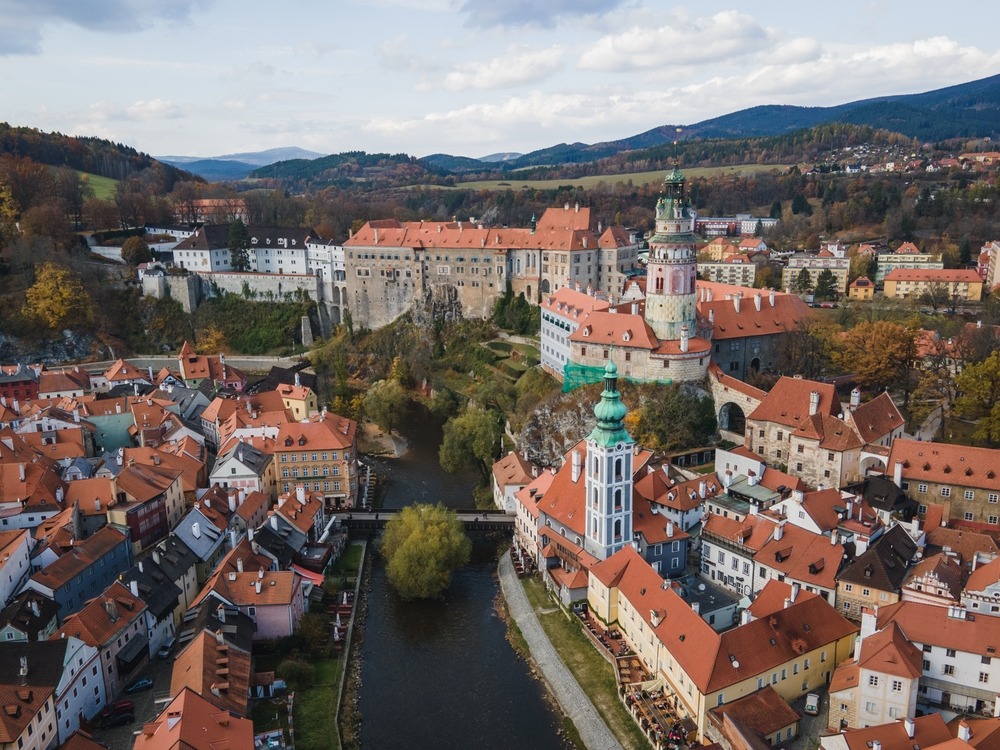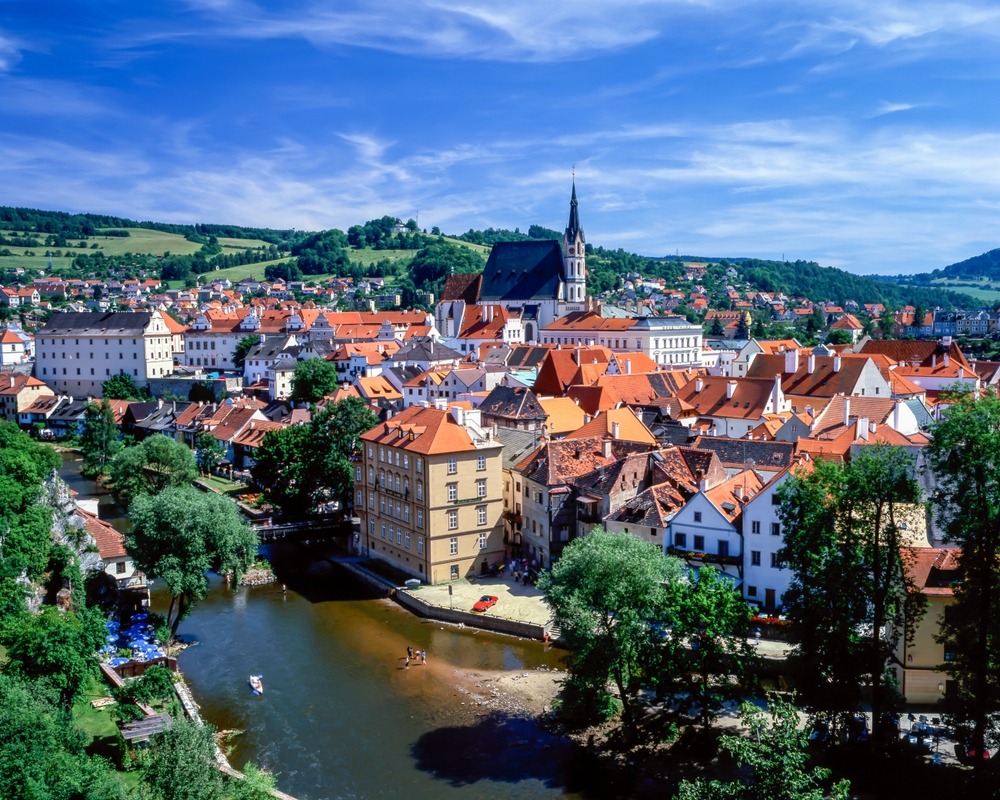Český Krumlov: A Timeless Jewel in the Heart of Bohemia
The History of Český Krumlov
Nestled in a serpentine bend of the Vltava River in southern Bohemia, Český Krumlov is one of the most enchanting and best-preserved medieval towns in Europe. With its origins dating back to the 13th century, the town is a living chronicle of Czech aristocracy, Renaissance elegance, and artistic heritage.
The earliest known written mention of Český Krumlov appears in a 1253 document referencing the castle, although the region was settled even earlier by Slavic tribes. The name “Krumlov” is derived from the German “Krumme Aue,” meaning “crooked meadow,” a reference to the curved shape of the river around the settlement.
The town’s development was closely tied to Český Krumlov Castle, established by the influential Vítkovci family, a noble Bohemian dynasty. Around 1302, when the Vítkovci line died out, the powerful Rosenberg (Rožmberk) family took control. Under the Rosenbergs, the town blossomed culturally and economically. They expanded the castle into a lavish Renaissance residence and welcomed artists, alchemists, and intellectuals to their court, making Český Krumlov a center of South Bohemian life.
In 1602, the Rosenbergs sold the estate to the Habsburg Emperor Rudolf II, who later granted it to the Eggenberg family as a reward for loyalty during the Thirty Years’ War. The Eggenbergs continued developing the town, but their lineage ended in 1719, and the estate passed to the Schwarzenberg family, who oversaw it until the 20th century. The Schwarzenbergs contributed significantly to the preservation and restoration of the town’s artistic and architectural treasures.
Following the fall of the Austro-Hungarian Empire after World War I, Český Krumlov became part of the new state of Czechoslovakia. During World War II, it was annexed by Nazi Germany, and its German-speaking population was expelled after the war ended. Under communist rule, the town saw limited maintenance, but its architectural integrity remained largely intact.
After the Velvet Revolution in 1989, Český Krumlov was gradually restored to its former glory. In 1992, UNESCO designated the town’s historic center as a World Heritage Site, recognizing its exceptional preservation and harmonious blend of Gothic, Renaissance, and Baroque architecture.
Today, Český Krumlov is a cultural treasure and an immensely popular tourist destination, often compared to a smaller, more intimate version of Prague—yet with a charm entirely its own.

Top Attractions in Český Krumlov
1. Český Krumlov Castle
Second only in size to Prague Castle, Český Krumlov Castle dominates the town skyline and is the crown jewel of South Bohemia. The complex includes 40 buildings, five courtyards, a beautiful rococo garden, and a unique Baroque theater. The Castle Tower, decorated with colorful Renaissance sgraffito, offers a breathtaking view of the entire town.
2. Baroque Castle Theater
Located within the castle grounds, this 18th-century theater is one of only a few surviving Baroque theaters in the world with original stage machinery, scenery, and costumes. Its preservation offers a rare glimpse into aristocratic entertainment during the Enlightenment.
3. Castle Gardens
Laid out in the 17th century, the formal gardens above the castle include a cascading fountain, a rococo summerhouse (Bellarie), and manicured lawns and flowerbeds—an ideal place for a quiet stroll.
4. Latrán Quarter
Below the castle, the Latrán district was once home to castle workers, craftsmen, and traders. Its cobbled lanes and pastel-colored Gothic and Renaissance buildings now house charming boutiques, cafes, and museums.
5. Old Town Square (Náměstí Svornosti)
The heart of Český Krumlov’s Old Town, this compact square features historical facades, a Marian column erected in gratitude for the end of the plague, and the Renaissance Town Hall. The atmosphere is festive, particularly during cultural events and seasonal markets.
6. Church of St. Vitus (Kostel sv. Víta)
This Gothic church, dating back to the 14th century, is an architectural highlight of the town. With its soaring nave and preserved frescoes, it has served as the spiritual heart of Český Krumlov for centuries.
7. Egon Schiele Art Centrum
A museum dedicated to Austrian Expressionist painter Egon Schiele, who had family roots in Český Krumlov. It features rotating exhibitions of modern art, as well as biographical exhibits on Schiele’s controversial yet influential career.
8. Regional Museum
Located in a former Jesuit seminary, this museum offers insight into the history, folklore, and daily life of the region through archaeological finds, folk costumes, and historic artifacts.
9. Moldavite Museum (Muzeum vltavínů)
This small but fascinating museum is dedicated to Moldavites—green tektite stones formed by meteor impacts and found mainly in South Bohemia. It includes luminous displays and geological explanations.
10. Monastery of the Minorites and Poor Clares
An atmospheric complex just beyond the castle, these medieval monastic buildings now host exhibitions, workshops, and interactive experiences focused on medieval craftsmanship and monastic life.
11. Graphite Mine Tour
For a truly unique experience, visitors can don helmets and ride a mining train into the labyrinth of a real graphite mine, once a key industry in the town. It’s a fascinating and hands-on lesson in local industry.
12. Brewery Eggenberg (Pivovar Eggenberg)
Founded in the 16th century, this brewery has historic roots tied to the noble families of the region. Visitors can tour the brewing facilities and sample traditional Czech lagers.
13. Synagogue of Český Krumlov
Built in 1909, the synagogue has been restored and now serves as a cultural center, housing exhibitions and hosting concerts and public events.
14. Wooden Raft Trips on the Vltava River
One of the most delightful ways to experience the town is by rafting or canoeing along the Vltava River, which offers splendid views of the castle and old town from the water.
15. The Cloak Bridge (Plášťový most)
A spectacular multi-story bridge connecting the castle to the theater and gardens, this architectural marvel spans a deep ravine and is adorned with arches, balustrades, and statues.
16. Marionette Museum
This whimsical museum inside the former Church of St. Jošt showcases traditional Czech puppetry, including antique marionettes and stage sets from the 18th and 19th centuries.
17. Wax Museum (Muzeum voskových figurín)
Located near the town square, this museum features life-size wax figures of Czech monarchs, medieval townsfolk, and famous personalities from European history.
18. Museum Fotoatelier Seidel
A preserved photography studio from the early 20th century, this museum offers a nostalgic view of life through the lens of Josef and František Seidel, pioneering photographers of the Bohemian countryside.
19. Mirror Maze and Torture Museum
A mix of kitsch and curiosity, these tourist spots offer a fun, if somewhat theatrical, look at medieval punishment devices and mirrored illusions.
20. Nighttime Castle Illuminations
Every evening, the castle and old town are softly illuminated, creating an ethereal atmosphere. A nighttime walk through the deserted streets feels like stepping back in time.
21. St. Jost Church and Art Gallery
Now a privately-owned cultural venue, this former church has been adapted into a fine art gallery with rotating exhibits in a dramatic setting.
22. Rafting the Vltava Rapids
For adventure seekers, short rafting trips on the mild rapids below the town provide excitement and sweeping views of the castle from below.
23. Kaplanka Tower
This small but picturesque tower near the Church of St. Vitus once housed the castle watchman. It’s a favorite photo spot due to its medieval aesthetic.
24. Český Krumlov International Art Festival
Held every summer, this festival fills the town with music, dance, and performance art, often staged in the castle courtyards, gardens, and streets.
25. Local Artisan Workshops
Scattered through the Latrán and Old Town districts are artisan shops specializing in handmade ceramics, wooden toys, calligraphy, and glasswork—offering both souvenirs and insight into Bohemian craftsmanship.

One of the most enchanting and best-preserved medieval towns in Europe
While it may be small in size, Český Krumlov is immense in character, charm, and cultural significance. Its centuries-old castle, winding streets, and riverside views enchant visitors who come seeking history, art, and atmosphere. A living museum under open skies, this South Bohemian town weaves the tales of knights and nobles, monks and painters, artisans and performers—offering a truly immersive journey into the heart of Central Europe’s medieval past and its vibrant present. Whether for a day trip or a longer stay, Český Krumlov leaves an impression that lingers like the soft echo of lute music across its cobblestone squares.

































